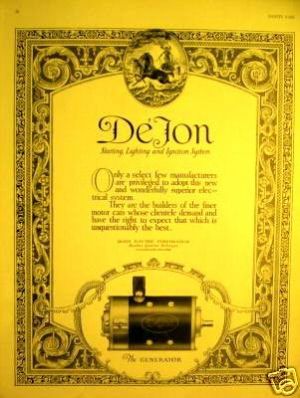- Home
- About Us
- Join/Renew
- Member Benefits
- Member Pages
- Log In
- Help
- Museum Store
David,
You should contact Tony Z.
Peter
Yes, It is UGLY!
William,
They are all 7-digit numbers and 511151 is listed as having been cut up to make a truck.
Peter
William,
NOPE!
Chassis number-511151 that was cut up into a truck from a 1919 7-Passenger Touring is as close as I can find.
Peter
Randy,
No match with the number 337025 on Bernie’s listing either.
And David is correct that it is a 1923 year model.
Peter
Curtiss,
De-Jon made high quality electrical do-dads in the 20s and such.
My Series 80 had a De-Jon starter when I acquired the car.
I have since acquired a De-Jon generator and distributor, even though I currently run a Delco-Remy starter, generator and distributor.
I have little doubt that Miles’ comment is correct and that De-Jon make the part for a 20s Pierce-Arrow, Series 36.
That is a rare and valuable find, especially considering the condition.
Peter

Gents,
I believe that Bob Sands is correct regarding the Postcard Pierce, versus the Quam Pierce.
The Postcard Pierce mentions 5-seats and the Quam Pierce is definitely not with the 5-seats.
Stu’s link, or at least the YouTube video associated with it, shows Grant Quam driving his Pierce and a quick look at the back seating shows no seating at all.
Peter
Ed,
The car also does not show up in the 2018 PRINT Roster when I did a search by both chassis and engine number.
There is a one-digit gap (2215224 — 2215226 & 314374 —- 314376) where it would be listed.
Peter
Ed,
Bernie’s list indicates that it is a 1601 and may be last owned by a Grant Quam of Ames, Iowa, chassis #2215225, engine #314375.
There is no such person in the 2018 PAS Roster, however an internet search provides the info shown on this website with the Pierce-Arrow up front!.
Peter
Tony,
Thank You!
Peter
Bob,
Dilly, Dilly back at you!
Peter
George,
I believe that the number of angels that can dance on the head of an oil pump stud depends upon whether they are dancing a Waltz, a Fox Trot or the Charleston.
Regardless, the number is somewhere infinitely north of Avogadro’s number, which is of course, 6.022140857 × 10 to the 23rd.
Peter
Jim,
Also, if you have a spare oil pan, you can always do the stud removal program on the spare and then swap pans.
Peter
Jim,
With all due respect to Greg’s significant mechanical prowess, I offer these comments.
Liberal amounts of PB Blaster (two or three times, a few days in advance), a touch of heat to the tips of the studs and a GOOD Stud Pulling Socket, should do the trick to remove the studs without a break.
You will likely not do this again in your lifetime, so wear on the threaded part of the aluminum crankcase caused by hex-head screws / bolts is not really an issue.
Also, if you use your brain, after removing the studs, you will measure the depth of the blind holes in the crankcase and determine the thickness of the base of the oil pump.
If you then buy hex-head machine screws / bolts that are slightly shorter than your full depth, including pump base thickness and lock washers, you will not reach the blind end of the bolt hole and will not crack the crankcase from inserting and torquing too long of a bolt.
Finally, if you do this prep work, the oil pump will just go in like a charm.
Proper Project Preparation Prevents Piss Poor Performance (the Seven Ps for Success).
Cheers,
Peter
Karl,
Make sure that you use the hotels about which I sent you the info.
A Room Rate of $7.00 per night is hard to beat!
Perhaps, you should post a photo of the brochure for the hotel. 
Peter
Karl,
In case it was not clear from my posting above, Arthur J. Chanter was the Vice President / General Manager of the PAMCC and he was the Toastmaster for the PAMCC event held at The Plaza Hotel in Manhattan on 5 January, 1929.
A Pierce-Arrow Class luncheon in a Pierce-Arrow Class hotel in Manhattan.
Peter
Jim,
Years ago, I did as George suggested above.
It makes a HUGE difference in properly placing the oil pump on my Series 80.
I have great oil pressure and do not leak a drop of engine oil.
I don’t recall exactly, but I believe that I made my own gasket from a standard gasket material package that I bought at NAPA.
Peter
Studebaker acquired Pierce in 1928 through a stock transfer. Pierce remained ostensibly independent with its own general manager, Arthur J. Chanter, though Erskine named himself president. More importantly, Buffalo and not South Bend would retain responsibility for developing new Pierce-Arrows.
Charles,
To make a photo smaller, I open it with PREVIEW (maybe just a MAC program?) and then go to the dropdown that offers “RESIZE.””
I then change one of the numbers to be at approximately 40% of the original and the program automatically proportionately sizes it.
It is not a big deal.
Peter
“
Charles,
I understand that your truck has the same engine in it as Series 80 cars.
That is useful to know when it comes to hunting for parts.
Oh, does it have a cast-iron or an aluminum cylinder head?
If cast-iron, then Series 80, if aluminum, then Series 81.
Peter
